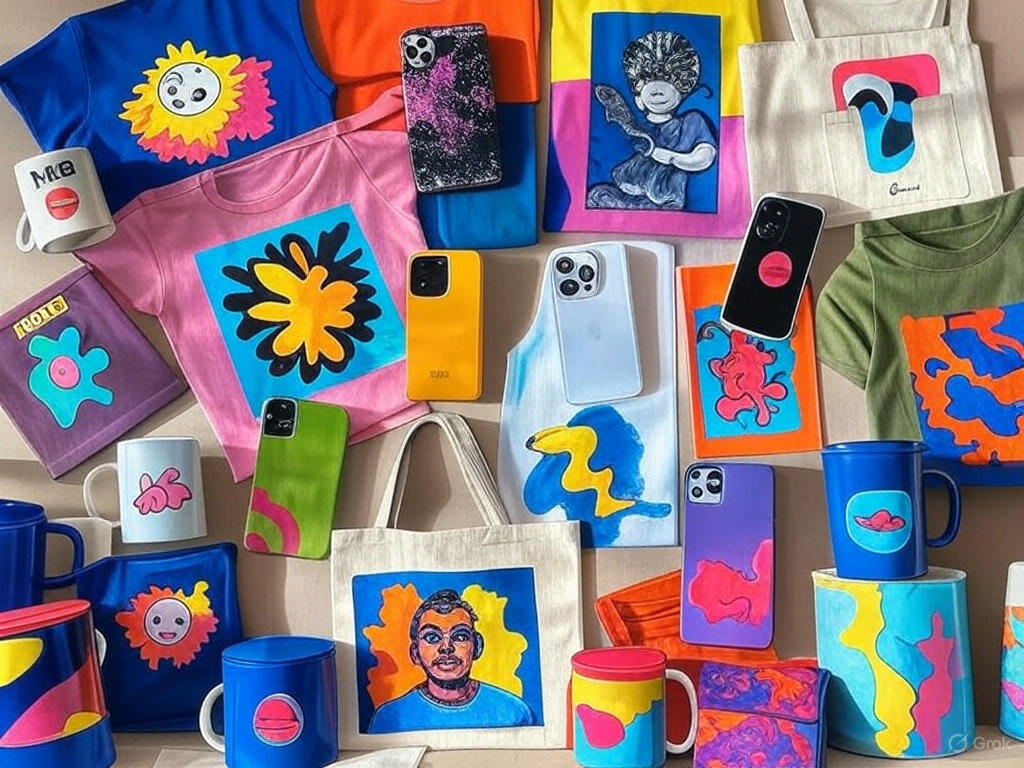The allure of e-commerce, particularly business models with low entry barriers, has captivated entrepreneurs for years. Print-on-Demand (POD) surged in popularity as a seemingly easy way to start an online business without inventory risks or hefty upfront investments. But as the market matures and competition intensifies, a crucial question arises: is print-on-demand still profitable in 2025?
The simple answer is yes, but with significant caveats. Gone are the days when slapping a generic design on a t-shirt guaranteed sales. Today, profitability in the POD space requires strategy, differentiation, and a keen understanding of the market. This article dives deep into the current state of POD, exploring the factors that influence profitability and outlining the steps needed for success.
Table of Contents
What Exactly is Print-on-Demand? (A Quick Refresher)
Before dissecting its profitability, let’s briefly recap the POD model. Print-on-Demand is an order fulfillment method where products (like t-shirts, mugs, posters, phone cases, etc.) are printed with your custom designs only after a customer places an order.
Here’s how it typically works:
- You create designs.
- You upload these designs to products listed in your online store (e.g., Shopify, Etsy, Amazon).
- You partner with a POD service provider (like Printful, Printify, Gelato).
- A customer orders a product from your store.
- The order is automatically sent to your POD provider.
- The provider prints your design onto the product, packs it, and ships it directly to the customer under your brand.
- You pay the provider for the product and fulfillment; the difference between their cost and your selling price is your profit.
The key benefit remains: no need to buy or hold inventory, manage printing, or handle shipping logistics yourself.
Addressing the Core Question: Is Print-on-Demand Still Profitable?
The landscape has undeniably changed. Increased competition means more sellers vying for customer attention. Platform fees, advertising costs, and the base cost of goods from POD providers can eat into margins. So, why is the answer still “yes”?
Profitability hinges less on the model itself and more on the execution. While the market is crowded, opportunities exist for those who approach POD strategically. Success isn’t guaranteed, but print-on-demand still profitable ventures share common traits: smart niche selection, high-quality designs, effective marketing, and excellent customer service. It’s no longer a passive income stream; it requires active effort and business acumen.
Key Factors Influencing POD Profitability in 2025
To determine if POD can be profitable for you, consider these critical elements:
1. Niche Selection: The Foundation of Success
Trying to appeal to everyone is a recipe for failure in today’s POD market. Deeply understanding and targeting a specific niche is paramount.
- Passion Niches: Hobbies (fishing, knitting, gaming), pets, specific professions, social causes.
- Underserved Markets: Look for groups or interests with limited dedicated merchandise.
- Trend Awareness: Capitalize on current trends, but be mindful they can be short-lived. Build a brand beyond just trends.
Thorough research using tools like Google Trends, social media listening, and marketplace analysis (Etsy, Amazon) is crucial.
2. Design Quality and Uniqueness
Mediocre designs get lost in the noise. Your designs must resonate with your target niche and stand out.
- Originality: Avoid generic clip art or designs easily replicated. Develop a unique style.
- Quality: Ensure designs are high-resolution and suitable for printing on various products.
- Relevance: Designs should genuinely appeal to the interests and aesthetics of your chosen niche.
Investing in design skills or hiring talented designers can be a worthwhile expense.
3. Product Selection and Diversification
While t-shirts are the classic POD product, relying solely on them limits potential.
- Explore Variety: Consider hoodies, sweatshirts, tank tops, mugs, phone cases, posters, tote bags, stickers, home décor items, etc.
- Match Products to Niche: A knitting enthusiast might appreciate a custom tote bag or mug more than another t-shirt.
- Quality Matters: Choose POD providers and base products known for good quality to minimize returns and build customer loyalty.
4. Choosing the Right POD Platform and Provider
Different providers (Printful, Printify, Gelato, CustomCat, etc.) offer varying product selections, print quality, pricing, shipping times, and integrations.
- Compare Costs: Factor in base product costs, printing fees, and shipping rates.
- Check Quality: Order samples to verify print quality and product feel before selling.
- Integration: Ensure seamless integration with your chosen sales channel (Shopify, Etsy, WooCommerce, etc.).
- Reliability: Research provider reviews regarding production times and fulfillment accuracy.
5. Strategic Pricing
Pricing is a delicate balance. Price too low, and your margins disappear; price too high, and you deter customers.
- Calculate Costs: Accurately determine your cost of goods sold (COGS), including product base cost, printing, shipping, and marketplace/platform fees.
- Factor in Expenses: Account for marketing costs, design expenses, and software subscriptions.
- Market Research: Analyze competitor pricing within your niche, but don’t solely base your price on theirs – consider your unique value.
- Perceived Value: High-quality designs and strong branding can justify higher prices.
6. Marketing and Branding: Getting Seen
You can have the best designs and products, but without visibility, you won’t make sales. This is often where aspiring POD sellers stumble.
- Build a Brand: Create a cohesive brand identity (logo, voice, story) that resonates with your niche.
- SEO: Optimize your product listings (titles, descriptions, tags) on your store and marketplaces.
- Social Media Marketing: Engage with your target audience on platforms like Instagram, Pinterest, Facebook, TikTok.
- Content Marketing: Create blog posts, videos, or guides related to your niche to attract organic traffic. Leveraging platforms like YouTube can be powerful; interestingly, you don’t always need to be the face of the channel. Explore these 7 Best Ways to Earn Money from YouTube Without Making Videos for ideas on how video content could potentially support your POD brand’s visibility.
- Paid Advertising: Consider targeted ads (Facebook, Instagram, Google Ads) once you understand your audience and have validated products.
- Email Marketing: Build an email list and nurture leads with exclusive offers and content.
Staying updated on effective strategies is crucial. Resources like the Shopify Blog offer great insights into the ever-evolving world of e-commerce marketing.
7. Customer Service
Positive customer experiences lead to repeat business and good reviews. Respond promptly to inquiries, handle issues professionally, and manage expectations regarding shipping times.
Pros and Cons of POD in 2025
Pros:
- Low Startup Costs: No inventory investment needed.
- Low Risk: Only pay for products when they sell.
- Wide Product Range: Easily offer diverse items.
- Flexibility: Run your business from anywhere.
- Scalability: Easy to handle increasing order volumes (provider handles fulfillment).
Cons:
- Lower Profit Margins: Compared to buying in bulk, per-item costs are higher.
- Dependence on Provider: You rely on their quality, stock, and shipping times.
- High Competition: Standing out requires significant effort.
- Quality Control Challenges: You don’t physically see every item shipped.
- Longer Shipping Times: Products are printed on demand, adding to fulfillment time.
The Verdict: Profitability Requires Strategy
So, is print-on-demand still profitable? Absolutely, for those willing to treat it like a real business, not a get-rich-quick scheme. Success hinges on differentiating yourself through niche focus, unique designs, quality products, and robust marketing efforts.
Profitability isn’t automatic; it’s earned through diligent research, continuous testing, adaptation, and a customer-centric approach. If you’re prepared to invest the time and effort required to build a genuine brand and effectively reach your target audience, then the Print-on-Demand model still holds significant potential in 2025 and beyond.





